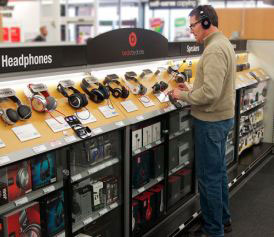Merchandising for the Connected Consumer
Ron Bowers
SVP, Business Development
Frank Mayer & Associates
 Who is the connected consumer?
Who is the connected consumer?
With a constant connection to the web and social media via a smart mobile device, the connected consumer is an informed shopper actively seeking the best value for a desired good.
With their own personal audience via the web and social media, they are an empowered group with a desire to feel appreciated by a retailer and in control.
What does this mean for retailers?
The connected consumer is a new challenge for retailers as power has shifted from the company to the consumer. With demands for a relevant, efficient and consistent experience for his/her own personal interests, and control over the conversation, retailers must provide the connected consumer a great shopping experience while merging both digital and in-store channels.
The consumer is engaged through digital technology before ever stepping foot in a store or looking at a catalog. It is possible that the first engagement isn’t facilitated by a retailer at all, but by a friend on social media. For this reason, marketers must have a strong digital strategy that enables consumer engagement across multiple channels and allows for a personalized interaction. Retailers should connect with consumers through various tactics such as emails, social media and in-store engagement while maintaining consistent brand identity and messaging.
To do this, retailers must understand the change in 1) how a customer shops, 2) how a customer makes in-store decisions, and 3) what the expectations of their customers are. The retailers must then develop a customized and distinct response to these questions as their digital strategy, and as a platform for merchandising.
How does this relate to brick-and-mortar stores?
Merchandising for the connected consumer
The in-store experience is still a powerful aspect of the buyers’ journey even though the digital entity of retail has become fundamental to the entire consumer experience. To best serve the connected consumer while creating store traffic and greater brand loyalty, the in-store experience should act in unison with the retailers’ digital strategy.
Knowing that the connected consumer utilizes technology to efficiently gain information and make a purchase decision, a sales associate no longer convinces a customer of a purchase. In fact, research shows that customers would rather use their own device followed by an unmanned device like a kiosk or tablet, before speaking to a sales associate to gather information in-stores¹. Thus, retailers should incorporate digital entities with the brick-and-mortar, or rather create an in-store shopping experience that utilizes technology and enables the consumer to stay connected.
The following are a few possible ways retailers can merchandize to the connected consumer in-stores:
1. Offer free in-store Wi-Fi
The consumer can stay connected while shopping.
A retailer has the opportunity to direct the consumer to the store website and current sales or product information after log in.
2. Utilize interactive kiosks and tablets
The consumer has access to a greater variety of products with expanded online inventory, and vast product information and reviews.
A retailer has greater advertising space with interchangeable digital displays specified to a department and the time of day while providing easy access to store information, online ordering, product information, and faster more efficient checkouts.
Incorporate beacon technology, a low-cost device utilizing a Bluetooth signal to directly communicate with a customer’s smartphone.
The consumer can receive personalized and targeted notifications for specified products and departments based on their current store location.
A retailer can communicate loyalty programs, payments and current advertisements in real time to a customer.
¹ “The New Digital Divide” by Deloitte Digital (2014).
This column was reprinted with permission from the Digital Screenmedia Association and originally appeared here.





